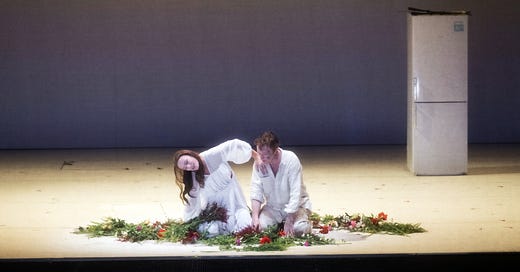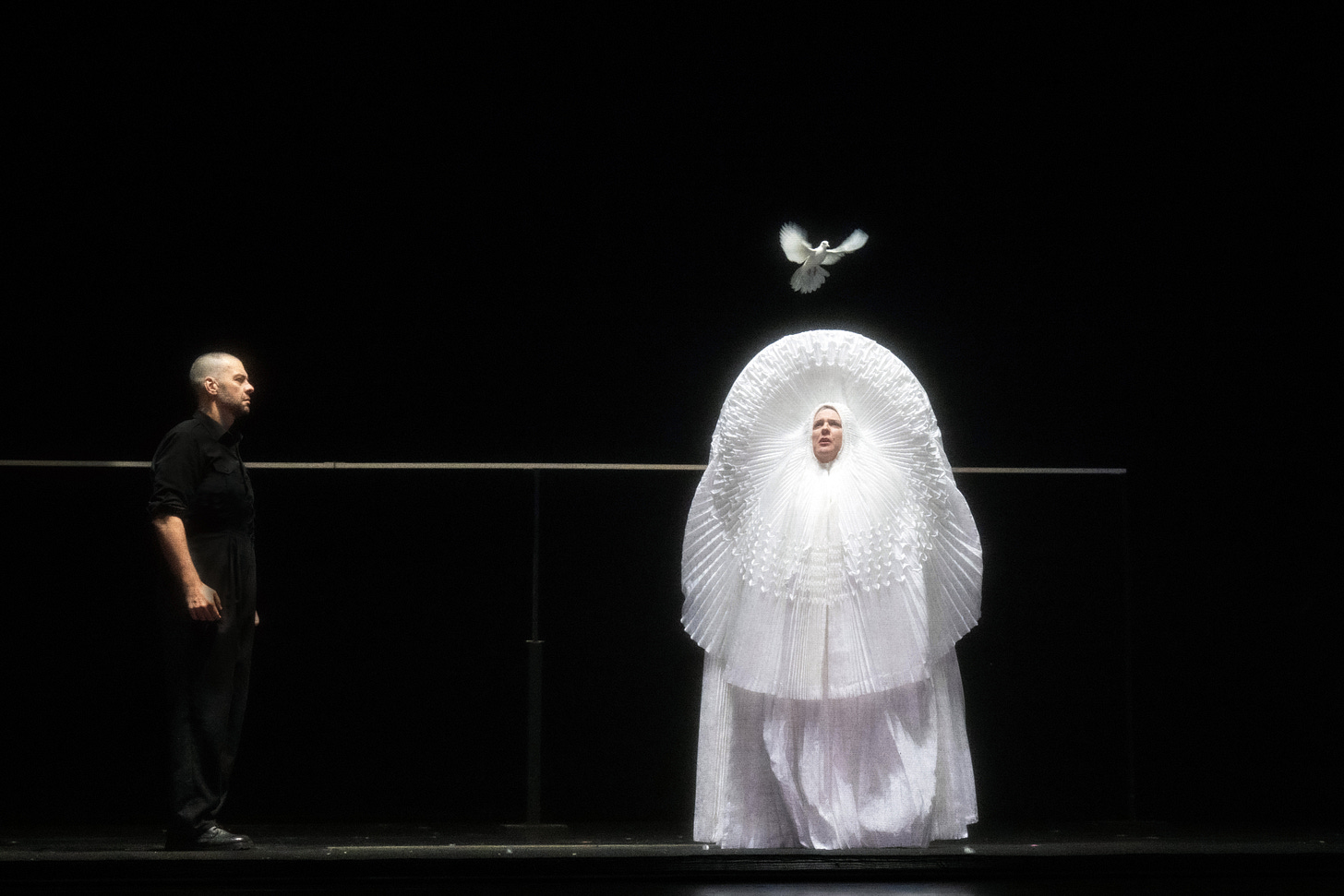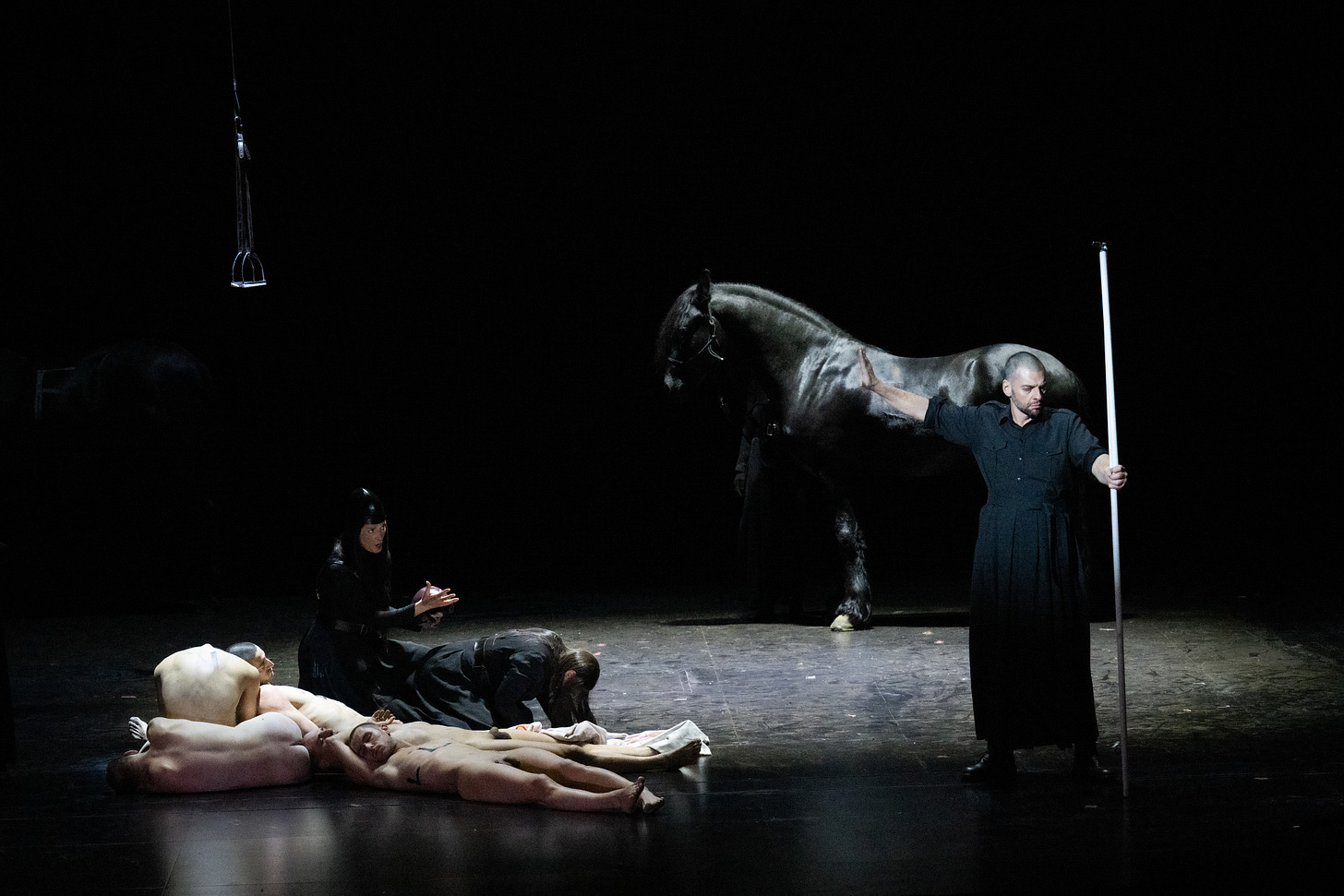Come into Castellucci's Wagnerian menagerie
The Italian iconoclast stages Die Walküre in Brussels
Du bist der Lenz (You are springtime) Nadja Stefanoff (Sieglinde), Peter Wedd (Siegmund) and fridge Picture by Monika Rittershaus
This article first appeared in Jan Geisbusch’s German translation on the website of Oper! Magazin. It is republished here for all subscribers to read by permission of the editor, Dr Ulrich Ruhnke
The origins of Romeo Castellucci’s Ring, to be shared with Barcelona’s Teatro Liceu, go back to 2011 — to the Italian director’s first work in an opera house, Parsifal (!) in Brussels. I saw it, somewhat bewildered, and my memories of it are vague and not especially positive. Since then Castellucci has become one of Regietheater’s stellar individuals, a maverick whose work now headlines the Bayerischer Staatsoper, the Wiener Festwochen and the Salzburger Festspiele.
Apart from the DVD of his Salzburg Salome, I have managed to avoid all of his post-Parsifal work — even his Tannhäuser starring Jonas Kaufmann last Easter at Salzburg. Indeed, I also missed his Brussels Rheingold last September, something I regretted after reading mostly positive reports of its rich visual imagery and a predominantly youthful cast under music director Alain Altinoglu. This Frenchman comes to the score of Die Walküre with fresh ears and a youthful sense of dramatic exploration. His conducting of Wagner’s propulsive thunderstorm representing Siegmund’s flight at the start of Act 1 suggested raw, hostile elements battering the Wälsung as Peter Wedd (replacing Eric Cutler) hurled himself against the membrane-like front curtain and – desperately – around the stage.
Castellucci’s Gesamtkonzept may not embrace the entire Tetralogy – he says the constituent music dramas are to be treated differently and the four works will not be performed as a cycle – but one might expect a certain coherence within the three acts of each evening. That Castellucci has thought a lot about the philosophy of DerRing des Nibelungen is clear from the Brussels programme book, which includes a conversation with the dramaturg Christian Longchamp covering Schopenhauer, Buddha — and animals. The Ring, of course, is a veritable menagerie of non-human sentient creatures, and I suppose Castellucci and his artistic collaborators should be congratulated for, as it were, taking the bull by the horns: they present Die Walküre with more (tamed) fauna than any production I have seen, although this distinction comes with caveats. The ‘Ride of the Valkyries’, for example, becomes a saunter, as Wotan’s daughters parade nine magnificent black horses around the stage at a pace statelier than its exhilarating orchestral accompaniment.
Goddess-as-sheep: Gabor Bretz (Wotan), Marie-Nicole Lemieux (Fricka) with live pigeon Picture by Monika Rittershaus
This is the most glaring example of how Castellucci’s ideas undermine Wagner’s music. His decision to play the first two acts behind gauze – necessary to prevent the circus act of 25 pigeons spilling out into the auditorium – has a similarly dampening effect: Wedd’s Siegmund and Ante Jerkunica’s Hunding (both charismatic performers) struggle to emerge vocally through this fog. Nadja Stefanoff’s Sieglinde, Ingela Brimberg’s Brünnhilde and Gabor Bretz’s Wotan, too, but at least they have the gauze-free final act to show their true vocal mettle: Semenoff finally triumphs with a glorious ‘O hehrstes Wunder’ in Act 3. Only the Fricka of Marie-Nicole Lemieux penetrated curtain and orchestra without effort, but even this superb singer was sabotaged by her ridiculous costume — a fashion-designer’s transformation of a woman into a sheep, further undermined by an entourage of timorous Fricka-lambs. Such eye-catching imagery may be intended to mask the lack of Personenregie in Castellucci’s conception. Even his animal tricks looked amateurish by circus standards — though Hunding’s black German shepherd fully deserved his solo curtain call.
Annunciation of death: Ingela Brimberg (Brünnhilde), Wedd (Siegmund), Stefanoff (Sieglinde)
The first Act is more-or-less a write-off: Siegmund, Sieglinde and Hunding have to compete with a ballet of perambulating furniture, a bed, Catholic confessional and refrigerator. Wedd draws the sword from Stefanoff’s bosom – before Wagner’s text and music say he does – and stores it in the pirouetting fridge, before the lovers get down to business in a coupling that leaves them drenched in blood and shame. That a director should look at the Wälsung twins through the eyes of Fricka is certainly novel, but I’m not sure it matches the ecstatic free spirit of Wagner’s musical depiction of their incestuous love. After Act 2’s pigeons and the theatrically inert horse-show in the famous ‘Ride’, I am tempted to dismiss Castellucci as another Robert Wilsonesque purveyor of opera-as-art-installation.
Gabor Bretz (Wotan), a Valkyrie and fallen heroes. Picture by Monika Rittershaus
At least the Valkyries made a strong vocal team, and the staging briefly ignited in the final confrontation between Brimberg’s valiant Brünnhilde — a not-quite-hochdramatisch achievement but an unfailingly touching and musical one — and Bretz’s handsome, youthful, lyrical Wotan. In his forgiving Farewell he at last found the vocal form and histrionic intensity to justify his status as one of the world’s rising young heroic baritones. After this, the climactic ‘Ring of Fire’ fizzled out like a damp squib. Maybe others will have found Castellucci’s ‘theatre of images’ more stimulating, and the audience seemed pleased enough. But for me, that lame finale summed up the staging as a whole.








Castellaccio?
Hmmmmm. Not sure it is one I shall be rushing to see. Shame the person playing the fridge is uncredited in the photograph! :-)